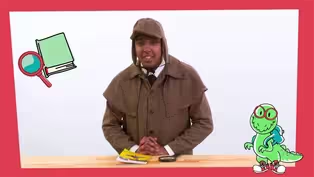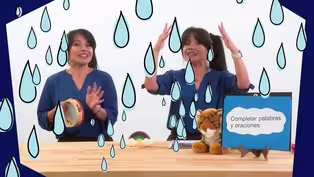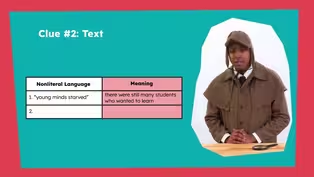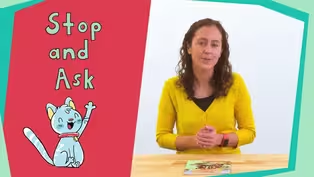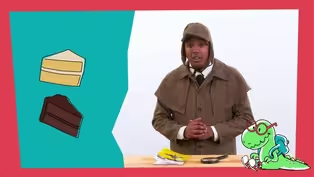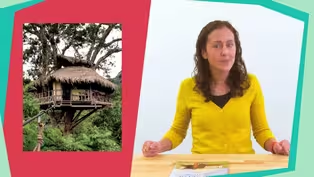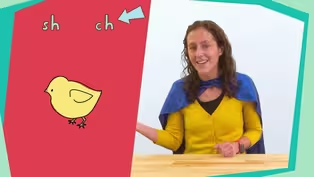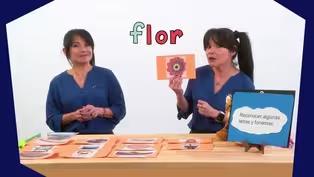
Episode 36 | Literacy Lessons
4/27/2021 | 28m 46sVideo has Closed Captions
Literacy lessons for early learners, led by NC teachers.
The first lesson (aimed at 3rd graders) teaches learners how to use context clues to determine the meaning of unknown words. The second lesson (also aimed at 3rd graders) explores multiple-meaning words in text. Classroom Connection is your At-Home Learning companion where children love to learn. All lessons are led by NC educators.
Problems playing video? | Closed Captioning Feedback
Problems playing video? | Closed Captioning Feedback
At-Home Learning Presents: Classroom Connection is a local public television program presented by PBS NC

Episode 36 | Literacy Lessons
4/27/2021 | 28m 46sVideo has Closed Captions
The first lesson (aimed at 3rd graders) teaches learners how to use context clues to determine the meaning of unknown words. The second lesson (also aimed at 3rd graders) explores multiple-meaning words in text. Classroom Connection is your At-Home Learning companion where children love to learn. All lessons are led by NC educators.
Problems playing video? | Closed Captioning Feedback
How to Watch At-Home Learning Presents: Classroom Connection
At-Home Learning Presents: Classroom Connection is available to stream on pbs.org and the free PBS App, available on iPhone, Apple TV, Android TV, Android smartphones, Amazon Fire TV, Amazon Fire Tablet, Roku, Samsung Smart TV, and Vizio.
Providing Support for PBS.org
Learn Moreabout PBS online sponsorshipMore from This Collection
Video has Closed Captions
Literacy lessons for early learners, led by NC teachers. (28m 46s)
Video has Closed Captions
Literacy lessons for early learners, led by NC teachers. (28m 46s)
Video has Closed Captions
Literacy lessons for early learners, led by NC teachers. (28m 45s)
Video has Closed Captions
Literacy lessons for early learners, led by NC teachers. (28m 45s)
Video has Closed Captions
Literacy lessons for early learners, led by NC teachers. (28m 46s)
Video has Closed Captions
Literacy lessons for early learners, led by NC teachers. (28m 46s)
Video has Closed Captions
Literacy lessons for early learners, led by NC teachers. (28m 45s)
Video has Closed Captions
Short Description: Literacy lessons for early learners, led by NC teachers. (28m 45s)
Video has Closed Captions
Literacy lessons for early learners, led by NC teachers. (28m 45s)
Video has Closed Captions
Literacy lessons for early learners, led by NC teachers. (28m 45s)
Video has Closed Captions
Literacy lessons for early learners, led by NC teachers. (28m 45s)
Video has Closed Captions
Literacy lessons for early learners, led by NC teachers. (28m 45s)
Providing Support for PBS.org
Learn Moreabout PBS online sponsorship[cheerful upbeat music] ♪ - What's up, my super learners.
It's another great day to learn and play.
But before we get started, let me see you ride that wave.
Come on.
There it is.
I like that.
I'm so excited you're tuned in to "Classroom Connection."
This is the world beyond the classroom, where we connect to the world right at home.
We got some math, we got some reading, but also we got some of the dopest corners in the world coming to you all in the next 30 minutes.
You ready?
Me too.
Let's see that wave one more time.
Yeah, there you go.
Let's do it.
- Hi, everyone.
My name is Ms. Shakemia, and I'm going to be your partner in learning for the next few lessons.
I don't know about you, but I love working together with others because I get to grow my brain and learn from everyone around me.
I hope that we can have fun and grow our brains together.
Have you ever been reading a story and all of a sudden you come to a word that you don't know?
That's happened to me before.
And I'll let you in on a little secret.
It still happens to me as a grownup.
It happens to everyone, and that's okay, as long as you have some strategies for what to do when you figure out what the unknown word means.
One way we try to figure out what the word means is by using the context around the word to inform our thinking, and to help us determine which words have effect on the overall meaning in a text.
Today, we'll be learning how to use context clues to help us figure out what the unknown words mean.
Context clues are words or groups of words that surround the unknown word, giving us clues that help inform our thinking.
We can use context clues in a sentence or paragraph to determine the meaning of an unknown word in any type of text.
There are different types of context clues, but for today's purposes, we're gonna focus on these two types: examples, which means that the author gives us an example of the word within the sentence, and definition, and that means that the meaning of the word's explained by the other words around it.
We can use these clues to help us make inferences about the meaning of unknown words in any type of texts that we read.
Now that we know all about the two different types of context clues, let's discuss a four-step process for determining the meaning of unknown words.
[air whooshing] When we're reading and we get to a word that we don't know but the word impacts the meaning of the text, we have to use the context around the word to guide our thinking, helping us figure out its meaning.
So the first step is to stop and identify the unknown word.
Step two is to use the context around the word to help guide our thinking as to what the word means.
We wanna ask ourselves, "What clues can we gather to figure out the meaning?"
Step three is to make an inference of what we think the word means based on the context clues surrounding the unknown word and what we already know.
And finally, step four is to check our inference or word meaning in context.
This means that we must read the sentence again, but this time substitute our inference or word meaning to see if it makes sense in the text.
Phew!
I know I just said a mouthful, but the more we practice these steps, the easier and quicker the process will be.
So let's get to it, shall we?
Let's practice identifying unknown words and using the context around them to help inform our thinking as we read an excerpt from one of my favorite fables titled "The Wind and the Sun."
As I read the first paragraph, I want you to follow along and keep your eyes peeled for three words I have identified as our unknown words.
These words will appear in bold print.
Remember, our first step is to do what when we come to a word we don't know?
That's right, stop.
I want you to signal me to stop by clapping your hands twice [clapping] when you hear me say the first bold word.
Here we go.
"One beautiful day in the park, the sun and the wind were having a chat.
The wind boasted, 'I am so much stronger than you.'"
What was that?
Did you clap twice?
That's right.
The word boasted is in bold.
So let's try to figure out the meaning of this word.
That means we are ready for step two.
What do we do after we identify the unknown word?
That's right.
We use the context around the word to help guide our thinking as to what the word means.
In this case, the author is using an example as a context clue to help us understand boasted since the wind is quoted as boasting, "I am so much stronger than you."
So now that we've identified a helpful context clue, it's time to move to step three.
What do we do in step three?
Right, we make an inference using the context clues and our own knowledge.
I know that if someone says, "I am so much stronger than you," they are trying to brag.
So I think boasted means to brag, which is my inference.
Now, let's move to step four of our process and check my inference.
I want you to re-read this sentence out loud with me and to substitute bragged for boasted.
If the sentence makes sense, show me a thumbs up.
If it doesn't make sense, show me a thumbs down.
Are you ready?
Let's start.
The wind bragged, "I am so much stronger than you."
Does this sentence make sense?
I see lots of thumbs up.
That means my thinking was correct.
Now it's your turn.
We're going to continue reading through this paragraph together.
We will begin reading at the third sentence.
While I'm reading, I want you to yell stop when I get to our next bold word.
That way we will know it's time to stop and use our four steps to help us figure out what that word means.
What are you going to do when you see a bold word?
That's right.
Stop.
Here we go.
"The sun just smiled politely, but did not say a word.
'Since you don't believe me, let's have a competition to see who's stronger!'
said the wind, flexing its muscles.
The sun reluctantly nodded his head in agreement."
Wow, you all are on the ball.
You noticed that agreement was in bold.
This means that we've completed step one and have identified an unknown word.
Well, you know what that means.
It's time for step two.
We need to look for some context clues to better understand our unknown word.
So let's reread the sentence.
"The sun reluctantly nodded his head in agreement."
Hmm.
Let's use the context around the word to help guide our thinking as to what that word might mean.
Once again, the author has given us clues by using an example.
What did you notice?
Ah, I think you're right.
The text says that the sun nodded its head.
Now we're gonna move to step three in our process and make an inference about what this word means based on the context clues and what we know.
What do you know about what it means when someone nods their head?
Exactly.
That usually means that they are saying yes to something.
So if the sun was nodding in agreement, that means she was saying yes to the competition.
Now, let's check our thinking in step four of our process.
You re-read the sentence and substitute our understanding of the word's meaning in the sentence.
If the sentence makes sense, show me a thumbs up.
If the sentence does not make sense, show me a thumbs down.
Ready?
Go.
[gentle music] Great.
I heard many of you say, "The sun reluctantly said yes to the competition."
And then I saw you giving me a thumbs up.
You all are excellent context clue finders.
We have one more word to define, so let's keep going.
Let's pick up where we left off in the text.
Remember to yell stop when you notice the bold word.
Ready?
Let's read.
"At that moment they saw a man wearing a jacket out for a stroll, a very slow walk, to get some fresh air."
Great job.
You noticed stroll.
Since we've identified stroll as our unknown word in step one, now it's time for step two: use the context around the word to help guide your thinking of what the word means.
Here's the sentence again.
"At that moment they saw a man wearing a jacket out for stroll, a very slow walk, to get some fresh air."
What context clues did you notice that help you understand the word stroll?
[bright music] Right, after the word stroll, the author includes a definition.
A stroll is a very slow walk.
When the author provides us with a definition for an unknown word in a text, that really helps us out because we can skip step three of our process.
We don't need to make an inference about what the word means because we already know its meaning, thanks to some extra information from the author.
So onto step four, we need to check our word meaning in context.
Let's read our sentence together.
At that moment, they saw a man wearing a jacket out for a slow walk to get some fresh air.
Give me a thumbs up if you think this sentence makes sense and a thumbs down if it doesn't.
Awesome, I see lots of thumbs up.
So we know that the author was helping us understand the word stroll by providing us with a context clue definition of a very slow walk.
You all are becoming pros at finding context clues for unknown words, which means that we've accomplished our goal for today.
So now we get to celebrate.
I'm going to count to three and we're all going to kiss our brains, just like this.
[lips smacking] Are you ready?
One, two, three.
[lips smacking] Today, we learned how to use context clues to determine the meaning of unknown or confusing words.
We learned some of the different types of context clues that we can use to help us.
Then we used four steps to infer the meaning of each word.
Remember, one of the most important steps is to check to see if your inference or word meaning makes sense when substituted in the sentence.
You can use this four-step strategy with unknown words in any text that you read.
You are well on your way to becoming even better readers and thinkers.
Thank you for letting me be your partner and learn today.
Until next time, see ya!
[air whooshing] - Hey, everybody.
That was awesome.
I bet you know something now that you didn't know yesterday.
When you use your beautiful brain, it helps you understand more about the world we live in.
Just like eating your veggies helps you grow strong, practicing your reading helps your brain get big and strong too.
[chill music] - Hi, everyone.
I'm Ms. Raven, and today we are going to get active.
I want you guys to join me by moving your arms from side to side.
[soft hip hop music] We're just gonna swing them here.
And every time I swing, my toe is tapping.
Good job, and we'll lift them up.
And back to our center.
And this time we're just gonna curl our biceps in.
And back to center.
You're doing great.
We're gonna come up this time.
Here we go, and up!
And back to center.
Good, and biceps.
Great job, and thank you for joining me today.
I will see you next time.
- Hey, guys!
My name is Kat.
I am one of the aviculturists here at Sylvan Heights Bird Park.
And you can see, I got a couple of friends with me right here.
These are called nene geese.
These birds are native to Hawaii and they're only native to the Hawaiian islands.
So this is often referred to as an endemic species.
So it's a very, very unique bird.
So this bird used to be found on all of the islands of Hawaii.
They used to estimate that there was about 25,000 nene geese on the Hawaiian Islands.
Now, that doesn't seem like a big number but that is a pretty considerate number when you consider how small the islands of Hawaii are.
But unfortunately, this bird is no longer at those numbers.
This is a critically endangered bird, or now they're listed as threatened, which is a good thing, we'll get to that in a second.
So around when the Europeans came to the Hawaiian Islands, they brought other animals with them.
Some intentional, some non-intentional such as rats and weasels and hogs and things like that, and cats and dogs.
This, unfortunately, caused the nene's numbers to crash to as low as 30 birds.
So they were critically endangered.
Thankfully, though, in the recent years, thanks to captive breeding programs including ones here at Sylvan Heights, and, of course, many that are on the Hawaiian Islands, this bird is on the rebound.
So like I said, they were now recently labeled as threatened, which is actually a lot better than critically endangered.
And they estimate now that there's between 2000 and 2500 nene geese on the Hawaiian Islands.
So they are definitely on the rebound.
Another really good sign is in 2013 was their first sign of wild reproduction of nenes on Hawaii.
So what that means is that they have, for now, halted all breed and release programs since the population seems to be doing that on its own.
[laughs] And you can see with these two right here that they tend to be pretty friendly.
And that's because these two are raised here at Sylvan Heights and they're munching on their favorite snack which is lettuce.
Another fun fact about the nene is for all the 50 states that have their state bird icons, the nene is the only one that is a waterfowl.
All right, guys, hope you had fun hanging out with me and the nenes.
Hope to see you next time at Sylvan Heights.
Bye-bye.
- That was so cool.
Science is amazing.
The world is full of amazing creatures and plants, making me wanna learn so much more about our planet.
I am so glad we got to see that.
[chill music] - Hello again, everyone.
My name is Ms. Shannon.
I'm so glad you're back with me to keep exploring this fantastic book called "Sun!
One in a Billion."
This book is unique because the author, Stacy McAnulty, included elements of both informational and fiction to make it more interesting.
So in this book, we're learning facts about the Sun in really fun ways.
[gentle guitar music] Last time we learned several multiple meaning words and phrases, which are words that have more than one definition.
And we practiced using them correctly.
It's always great to learn new words so that when we hear or read them, we can understand what's going on.
We can also use them when we write or speak to others.
Oh, look!
Here comes the Sun to join us again.
Last time, we created this chart to help us see that some words and phrases have literal and figurative meanings.
Let's use it to review the three multiple meaning words and phrases we discovered in the first part of the book.
We learned star, hang out, and revolve.
Remember that a star can be a literal ball of light and gas in outer space or figuratively, an entertainer, performer.
Hanging out can literally mean something sticking out of something else, or it can figuratively mean spending time with the same people or in the same place.
Finally, we learned that revolve literally means to move in a circle around something, and figuratively means that something or someone is the most important.
Now that we've done a quick review of figurative and literal word meanings, let's continue our chart challenge with the rest of the book.
[air whooshes] Today we're going to continue finding more multiple meaning words and phrases to add, and this time we're going to think more about how to determine what they mean.
Remember that some strategies we can use to determine word meanings include: using the words and pictures together, looking for antonyms, and checking a dictionary.
Remember these strategies so that when you're reading on your own, you can figure out word meanings in any text.
Are you ready to continue our chart challenge from last time?
Yes!
Let's get started, word detectives!
Watch me read this page and add the next word to the chart to remind you how to find and understand multiple meaning words.
Then you can help me with the rest.
"But you can't fill me with Earths because I'm hot stuff.
Compare: A hot summer day, 90 degrees Fahrenheit.
A pizza oven, 700 degrees Fahrenheit.
The orange-yellow flames in a campfire, about 2000 degrees Fahrenheit.
Me!
About 10,000 degrees Fahrenheit on the surface.
I can melt diamonds!
Me at my center, 27 million degrees Fahrenheit."
It says the Sun is hot stuff.
This phrase has two meanings.
How can we figure out what they are?
The literal meaning is easier to find.
We can use the words and pictures together to see that the Sun is much hotter than a summer day, a pizza oven, and a fire.
So hot stuff literally means having an incredibly high temperature.
[bright music] The figurative meaning is a little trickier to figure out, but we can use the same strategy: using the words and pictures together to think it through.
If we consider the book as a whole, we've seen over and over again on many pages that the Sun is very proud of itself and knows it's extremely important.
Like here, where it says directly that it is the most important.
And here, where it says it's outstandingly talented and popular.
This evidence helps us determine the figurative meaning of hot stuff.
Someone incredibly fabulous that others want to be around.
[gentle music] So, the Sun is literally made out of hot stuff with a very high temperature that can burn you, and the Sun is figurative hot stuff in this book because it's so loved, adored, and celebrated.
We can confirm this by checking a dictionary.
When I look up hot stuff, it says "used to refer to a person or thing of standing quality, interest, or talent."
So that matches what we figured out from the text by reading all around the word.
When's the last time you saw something that was literally hot stuff?
This morning, I had some coffee and that was definitely hot stuff.
Let's check in with our dogs, Spot and Muffin from last time.
Remember how Spot thinks that the world revolves around him?
That could also mean that he thinks that figuratively he's hot stuff.
How might Spot act since he thinks he's hot stuff?
Right, he might walk like this.
Now it's your turn, word detectives.
Read this page with me.
And as we read, try to find a multiple meaning word.
[air whooshes] "Not to hog the spotlight, but I've still got it.
I'm the same hot, bright star I've always been."
Did you find one?
I noticed the multiple meaning word hog.
When you hear the word hog, what do you think of?
I bet some of you thought of this.
Is that the literal or figurative meaning of hog?
Yes, that's the literal meaning of the word hog: a pig.
But it also has a figurative meaning, and the author uses hog figuratively in her book.
Which strategy should we try to figure out its meaning?
Let's try to use the text and pictures together to figure it out.
I'm noticing that the Sun is the only one on stage, so it's getting all the attention.
And it says it's hogging the spotlight.
No one else is in it.
So when you figuratively hog something, it means you're taking most or all of it and not leaving much for others.
[soft music] Let's use a dictionary again to double-check this.
When I look up hog, I see two definitions.
The first, literal one says "a domesticated pig."
And the second, figurative one says, "keep or use all of something for oneself in an unfair or selfish way."
So, that matches what we figured out.
Look up there at Spot.
He's hogging all the food.
Poor Muffin.
Let's think of things we might want to hog or get a lot of.
Maybe our favorite foods or something else we really like.
I might want to hog the TV and watch only things that I want to.
But I would need to be considerate and give others a turn.
Spot, quit hogging that food and give some to Muffin.
Good dog.
What's something you would probably not want to hog because it's something you don't like very much or it's not good to be around?
I would probably not hog someone's pet kitten even though kittens are cute because I'm allergic to cats.
They make me sneeze.
[air whooshes] Look, word detectives.
We've added two more words to our chart.
You're doing a great job with this challenge.
Now we found lots of multiple meaning words and phrases with figurative and literal meanings.
Let's keep going!
Read this page with me and look for the multiple meaning word.
"A stable star is a good star.
You don't want your Sun getting hotter or cooling off.
That would be really messy."
Did you find it?
Yes!
Stable has two meanings.
This one is a little different than the other multiple meaning words we found because it doesn't have a figurative and a literal meaning.
Instead, the two meanings of this word are just different parts of speech.
One is a noun, which is a person, place, or thing, and one is an adjective, which is a describing word.
We'll explore stable's two meanings more in just a minute.
But notice how this part of the chart is organized a little differently for multiple meaning words that can be used as different parts of speech.
So, word detectives, which strategy should we try to figure out stable's meaning in this book?
Let's see if we can use antonyms.
It tells us stable is good because we don't want it getting hotter or cooler.
So that means we don't want it to change much.
From that, we can figure out that stable means not changing.
The Sun's temperature is pretty stable because it doesn't get much hotter or colder.
So here, stable is an adjective because it's describing the Sun.
[air whooshing] [gentle music] Something else I can think of that is stable or doesn't change much is the color of my eyes.
That's not really changing.
So my brown eye color is stable.
Since we've been thinking about antonyms, can you think of something that is unstable, meaning it changes a lot?
Something I thought of that's unstable is the shape of a balloon when you're blowing it up.
It starts small but it keeps changing by getting bigger.
[soft music] That size was pretty unstable because it kept changing.
So now we know one meaning, but how can we figure out the other one?
I think we're gonna have to use the dictionary since using the text will only teach us about the meaning we already found.
When I look up stable, it says the adjective meaning is "firmly fixed" for the first definition that we already figured out.
So now we've double-checked that, which is great.
And for the second definition, it's a noun that means "a building for animals, such as horses and cattle."
So the other thing that stable can mean is a place where an animal lives.
What else might you expect to find in a stable along with a horse?
Yes, maybe some food, water, a brush for its tail, or anything else that a horse might need.
Great job finding so many multiple meaning words for our chart, word detectives.
You really rose to the challenge.
Okay, time for a review game to help remember the multiple meaning words and phrases we learned today.
Is fire literal or figurative hot stuff?
Yes, fire is literal hot stuff because it's so hot, it can burn you.
Figurative hot stuff is something that lots of people really like.
So something really cold like ice cream could actually be considered hot stuff if a ton of people love it.
Which kind of hog might you find in a stable?
This kind, which is the animal, or this kind, which is the person taking all the toys?
Yes, you'd find an animal in a stable.
And speaking of stable, which hog above is stable?
Yes, the hog that is still and not changing is stable.
And the one that keeps falling down is not stable because its position keeps changing.
We did it, word detectives!
We found multiple meaning words in the book, placed them on our chart, and used strategies to figure out what they mean.
Remember that some words and phrases can have both literal and figurative meanings.
Also remember that some words can be different parts of speech, which changes what they mean.
When you're reading, writing, and listening to words, see how many multiple meaning words and phrases you can find.
Remember to use strategies like checking a dictionary, using the words and pictures together, and looking for antonyms to figure out what words mean.
You can use these strategies with any book, not just this one.
See you again soon!
[air whooshing] - It's been another wonderful day, and I'm so glad we got to spend it together.
Peace, love, and learning, homies.
[cheerful upbeat music] ♪
Support for PBS provided by:
At-Home Learning Presents: Classroom Connection is a local public television program presented by PBS NC
